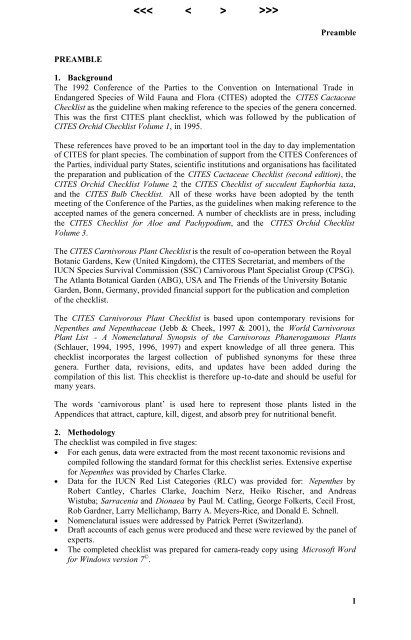CITES Carnivorous Plant Checklist - Royal Botanic Gardens, Kew
CITES Carnivorous Plant Checklist - Royal Botanic Gardens, Kew
CITES Carnivorous Plant Checklist - Royal Botanic Gardens, Kew
You also want an ePaper? Increase the reach of your titles
YUMPU automatically turns print PDFs into web optimized ePapers that Google loves.
Preamble<br />
PREAMBLE<br />
1. Background<br />
The 1992 Conference of the Parties to the Convention on International Trade in<br />
Endangered Species of Wild Fauna and Flora (<strong>CITES</strong>) adopted the <strong>CITES</strong> Cactaceae<br />
<strong>Checklist</strong> as the guideline when making reference to the species of the genera concerned.<br />
This was the first <strong>CITES</strong> plant checklist, which was followed by the publication of<br />
<strong>CITES</strong> Orchid <strong>Checklist</strong> Volume 1, in 1995.<br />
These references have proved to be an important tool in the day to day implementation<br />
of <strong>CITES</strong> for plant species. The combination of support from the <strong>CITES</strong> Conferences of<br />
the Parties, individual party States, scientific institutions and organisations has facilitated<br />
the preparation and publication of the <strong>CITES</strong> Cactaceae <strong>Checklist</strong> (second edition), the<br />
<strong>CITES</strong> Orchid <strong>Checklist</strong> Volume 2, the <strong>CITES</strong> <strong>Checklist</strong> of succulent Euphorbia taxa,<br />
and the <strong>CITES</strong> Bulb <strong>Checklist</strong>. All of these works have been adopted by the tenth<br />
meeting of the Conference of the Parties, as the guidelines when making reference to the<br />
accepted names of the genera concerned. A number of checklists are in press, including<br />
the <strong>CITES</strong> <strong>Checklist</strong> for Aloe and Pachypodium, and the <strong>CITES</strong> Orchid <strong>Checklist</strong><br />
Volume 3.<br />
The <strong>CITES</strong> <strong>Carnivorous</strong> <strong>Plant</strong> <strong>Checklist</strong> is the result of co-operation between the <strong>Royal</strong><br />
<strong>Botanic</strong> <strong>Gardens</strong>, <strong>Kew</strong> (United Kingdom), the <strong>CITES</strong> Secretariat, and members of the<br />
IUCN Species Survival Commission (SSC) <strong>Carnivorous</strong> <strong>Plant</strong> Specialist Group (CPSG).<br />
The Atlanta <strong>Botanic</strong>al Garden (ABG), USA and The Friends of the University <strong>Botanic</strong><br />
Garden, Bonn, Germany, provided financial support for the publication and completion<br />
of the checklist.<br />
The <strong>CITES</strong> <strong>Carnivorous</strong> <strong>Plant</strong> <strong>Checklist</strong> is based upon contemporary revisions for<br />
Nepenthes and Nepenthaceae (Jebb & Cheek, 1997 & 2001), the World <strong>Carnivorous</strong><br />
<strong>Plant</strong> List - A Nomenclatural Synopsis of the <strong>Carnivorous</strong> Phanerogamous <strong>Plant</strong>s<br />
(Schlauer, 1994, 1995, 1996, 1997) and expert knowledge of all three genera. This<br />
checklist incorporates the largest collection of published synonyms for these three<br />
genera. Further data, revisions, edits, and updates have been added during the<br />
compilation of this list. This checklist is therefore up-to-date and should be useful for<br />
many years.<br />
The words ‘carnivorous plant’ is used here to represent those plants listed in the<br />
Appendices that attract, capture, kill, digest, and absorb prey for nutritional benefit.<br />
2. Methodology<br />
The checklist was compiled in five stages:<br />
• For each genus, data were extracted from the most recent taxonomic revisions and<br />
compiled following the standard format for this checklist series. Extensive expertise<br />
for Nepenthes was provided by Charles Clarke.<br />
• Data for the IUCN Red List Categories (RLC) was provided for: Nepenthes by<br />
Robert Cantley, Charles Clarke, Joachim Nerz, Heiko Rischer, and Andreas<br />
Wistuba; Sarracenia and Dionaea by Paul M. Catling, George Folkerts, Cecil Frost,<br />
Rob Gardner, Larry Mellichamp, Barry A. Meyers-Rice, and Donald E. Schnell.<br />
• Nomenclatural issues were addressed by Patrick Perret (Switzerland).<br />
• Draft accounts of each genus were produced and these were reviewed by the panel of<br />
experts.<br />
• The completed checklist was prepared for camera-ready copy using Microsoft Word<br />
for Windows version 7 © .<br />
1

















